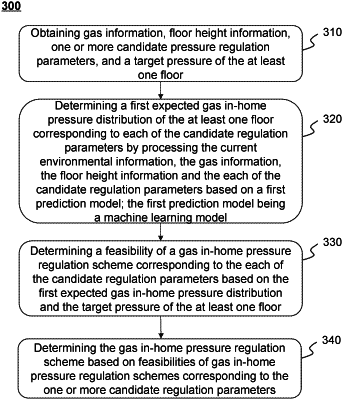| CPC G05B 19/416 (2013.01) [G05B 2219/41108 (2013.01)] | 6 Claims |

|
1. A method for regulating a gas in-home pressure based on smart gas, performed by a processor in a smart gas device management platform of an Internet of Things system for regulating a gas in-home pressure based on smart gas, and the method comprising:
determining a gas in-home pressure regulation scheme based on current environmental information, and the gas in-home pressure regulation scheme including a pressure regulation parameter of a gas device;
generating, based on the gas in-home pressure regulation scheme, a pressure regulation instruction;
regulating, based on the pressure regulation instruction, a gas in-home pressure of at least one floor; and
transmitting the gas in-home pressure regulation scheme to a smart gas user terminal, wherein the determining the gas in-home pressure regulation scheme based on current environmental information includes:
obtaining gas information, floor height information, one or more candidate pressure regulation parameters, and a target pressure of the at least one floor;
determining a first expected gas in-home pressure distribution of the at least one floor corresponding to each of the candidate regulation parameters by processing the current environmental information, the gas information, the floor height information and the each of the candidate regulation parameters based on a first prediction model; the first prediction model being a machine learning model;
determining a feasibility of a gas in-home pressure regulation scheme corresponding to the each of the candidate regulation parameters based on the first expected gas in-home pressure distribution and the target pressure of the at least one floor; and
determining the gas in-home pressure regulation scheme based on feasibilities of gas in-home pressure regulation schemes corresponding to the one or more candidate regulation parameters, wherein the determining a feasibility of a gas in-home pressure regulation scheme corresponding to the each of the candidate regulation parameters based on the first expected gas in-home pressure distribution and the target pressure of the at least one floor includes:
obtaining in-home standard pressure information;
determining a target pressure interval of the at least one floor by processing the floor height information and the in-home standard pressure information based on a second prediction model; the second prediction model being a machine learning model; and
determining the feasibility of the gas in-home pressure regulation scheme corresponding to the each of the candidate pressure regulation parameters by processing the first expected gas in-home pressure distribution of the at least one floor and the target pressure interval of the at least one floor based on an evaluation model; and the evaluation model being a machine learning model.
|